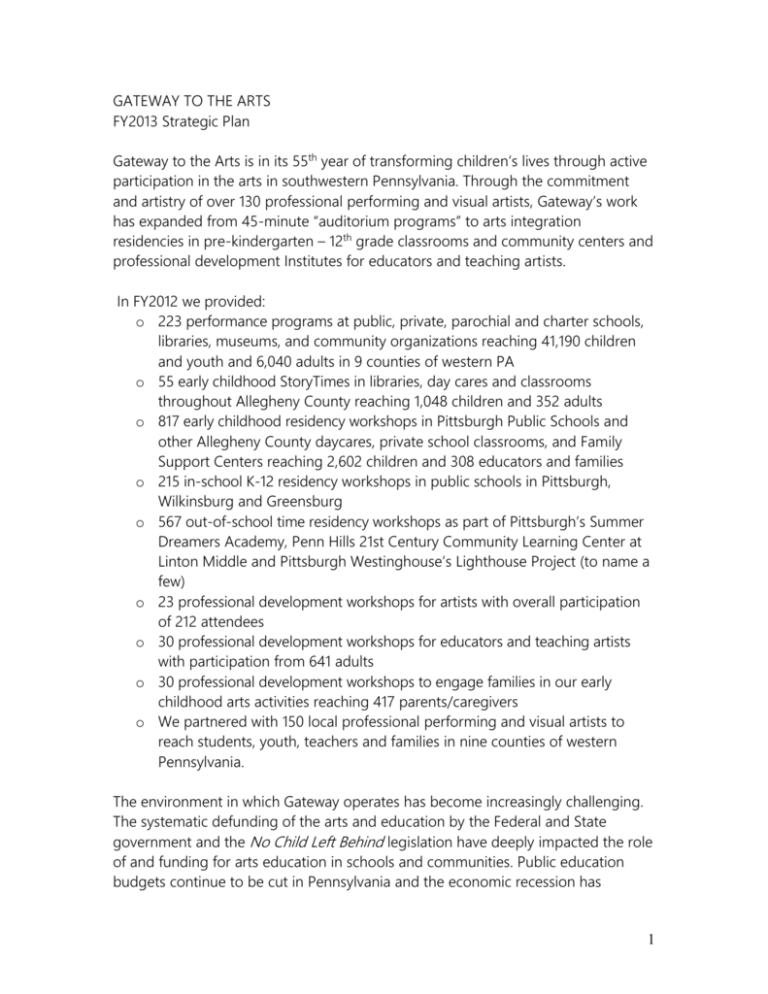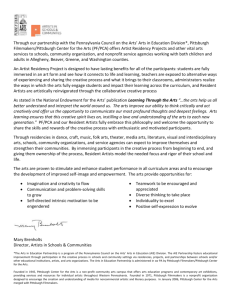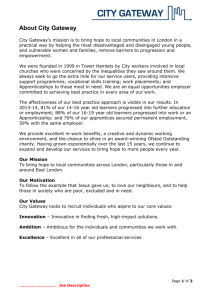GATEWAY TO THE ARTS
advertisement

GATEWAY TO THE ARTS FY2013 Strategic Plan Gateway to the Arts is in its 55th year of transforming children’s lives through active participation in the arts in southwestern Pennsylvania. Through the commitment and artistry of over 130 professional performing and visual artists, Gateway’s work has expanded from 45-minute “auditorium programs” to arts integration residencies in pre-kindergarten – 12th grade classrooms and community centers and professional development Institutes for educators and teaching artists. In FY2012 we provided: o 223 performance programs at public, private, parochial and charter schools, libraries, museums, and community organizations reaching 41,190 children and youth and 6,040 adults in 9 counties of western PA o 55 early childhood StoryTimes in libraries, day cares and classrooms throughout Allegheny County reaching 1,048 children and 352 adults o 817 early childhood residency workshops in Pittsburgh Public Schools and other Allegheny County daycares, private school classrooms, and Family Support Centers reaching 2,602 children and 308 educators and families o 215 in-school K-12 residency workshops in public schools in Pittsburgh, Wilkinsburg and Greensburg o 567 out-of-school time residency workshops as part of Pittsburgh’s Summer Dreamers Academy, Penn Hills 21st Century Community Learning Center at Linton Middle and Pittsburgh Westinghouse’s Lighthouse Project (to name a few) o 23 professional development workshops for artists with overall participation of 212 attendees o 30 professional development workshops for educators and teaching artists with participation from 641 adults o 30 professional development workshops to engage families in our early childhood arts activities reaching 417 parents/caregivers o We partnered with 150 local professional performing and visual artists to reach students, youth, teachers and families in nine counties of western Pennsylvania. The environment in which Gateway operates has become increasingly challenging. The systematic defunding of the arts and education by the Federal and State government and the No Child Left Behind legislation have deeply impacted the role of and funding for arts education in schools and communities. Public education budgets continue to be cut in Pennsylvania and the economic recession has 1 resulted in local foundations directing more of their resources towards essential human services. A report recently released by the Educational Policy and Leadership Center in Harrisburg on the challenges facing arts education in our State highlights the continued decrease of quality arts education in our schools. Over the last four years Gateway’s early childhood programming has grown through our partnership with Pittsburgh Public Schools Early Childhood Education Program and our affiliation with the Wolf Trap Institute for Early Learning in the Arts. Opportunities for Gateway to provide professional development workshops throughout our region to early childhood teachers and providers have increased through partnerships with the Southwest Regional Key and PAEYC, which led to new relationships with private early childhood centers. Our Western PA Wolf Trap residencies led us to begin working more with parents and caregivers through our parent engagement sessions (called “Show What We Know”) at the end of the residencies. These led to a new partnership with the Allegheny County Family Support Centers where we have provided mini-residencies and one long-term residency with quilter Tina Brewer over the last year. We launched a Family Performance Series, with support from the Charity Randall Foundation and the BNY Mellon Audience Development Fund of the Greater Pittsburgh Arts Council, to bring our engaging performance programs to communities throughout Pittsburgh. To date, we have provided these at the Pittsburgh Zoo/PPG Aquarium, the Charity Randall Theatre, the Kaufman Auditorium at Hill House and the Three Rivers Arts Festival. These are areas where we see greater opportunity for our work. But while our early childhood activities have grown, Gateway is seeing a huge shift in the educational and cultural environment in which we have worked for more than 50 years and opportunities for our partnerships in K-12 schools are diminishing. Most recently our Arts in Education Partnership program was eliminated from the Pine-Richland School District budget and we were unable to apply to Pittsburgh’s Summer Dreamer’s Academy due to budget constraints (their budget did allow for enough funds to ensure that our teaching artists would have support in the classrooms to provide quality arts learning). While the number of our artist partners has doubled (from 78 to 150) since 2000, we are seeing fewer opportunities to partner them in educational settings and challenges in successfully partnering them in out-of-school-time organizations. The Gateway Board and staff have begun to engage in thoughtful discussions about new directions Gateway might pursue in order to continue to play a unique and valuable role in supporting and nurturing arts education in our region while creating a sustainable financial model in which to deliver our programs. It is essential that Gateway’s board, staff and stakeholders take the time, to consider our business model, the community needs and our 2 competitive advantage and develop criteria that will assist us in identifying strategies and new partnerships to guide us into the future. Our tagline “Creative teaching. Lifelong learning.” has inspired our board to look for potential partnerships with adult learning and senior residential centers. With the enthusiasm and energy to make the most of our workforce of130 performing and teaching artists, the Board and staff were eager to embark on a strategic planning effort to undergo some thinking and conversations about strategies to help us successfully operate in this new environment. Gateway’s last major strategic planning effort took place in 2001 under the guidance of the Bayer Center for Nonprofit Management. This was a nine-month undertaking that included interviews with stakeholders, a development assessment, a review of program structure and evaluations and produced a document that included many goals and strategies and the budgets to support them. Since then, Gateway has developed three-year long-range plans with set goals for programs, fundraising, board development, and organizational structure. Our most recent plan, which ran through June 2012 has become increasingly irrelevant as we continue to see the elimination of cultural arts programming in schools and shifts in grant making. In the spring of 2012 Gateway created a Strategic Planning Task Force of key Board and staff and contracted Marilyn Coleman Consulting to perform stakeholder interviews to get a sense of the major issues affecting the advancement of arts education in southwestern PA and Gateway’s challenges and opportunities in that system. Following Ms. Coleman’s report to the board, the Task Force met to use the La Piana Real-Time Planning Process, led by board member Ann Felter, to identify our competitive advantage, create a strategy screen to help guide us in making decisions on new directions and identify the key questions facing the organization at this time. The key questions have now been directed to the Board committees where together with Gateway staff, action plans are being created to address the opportunities. What follows is a summary of key concepts from the process and the plan. Gateway to the Arts Competitive Advantages Quality of our professional development services Quality of our programs 3 Quality of our artists—our artists are paid for professional development, teaching and performing Arts administration expertise Community resource Mobile programming Program versatility Financially sound, no debt Strong staff Knowledge of PA Academic Standards and educational best practices Gateway network—funders, schools, artists, arts organizations, community organizations, etc Wolf Trap Institute for Early Learning through the Arts and Young Audiences Arts for Learning affiliations 4 Gateway to the Arts Trend Analysis Opportunities Demand for programs/services: Increasing (but money decreasing) Incorporate seniors – intergenerational arts learning/making STEAM (Science, Technology, Engineering, Arts, Math) - A new programmatic idea that funders are supporting and schools are interested in to advance student learning Challenges Available funding staying about the same sources are changing – less earned income dispersed differently Shortage of artists interested in this work Downsizing in schools, fewer students in the region, schools closing, charter schools opening School budgets Need to find, train and retain good artists Identity Statement Components of Identity Statement We advance our Gateway to the Arts’ Identity Statement mission of partnering with professional performing and visual artists from out community to integrate quality arts experiences into the lives of western PA students, educators, and families . . . and seek to Impact our community with integrated arts activities taught by quality, trained teaching artists (impact) by serving children, adults, seniors and families (utilizing a broad definition of family) (customers) in Southwestern PA (geographic area) through performances, workshops, residencies and professional development (programs or services) 5 and emphasizing our competitive advantages We are sustainable by through quality professional development through arts teaching and program versatility foundations, corporations, individuals, government, and program fees (funding sources) Gateway to the Arts Plan FY2013 1. Where will we get financing for our work? (Development Committee) Identify two fundraisers/networkers to add to the Development Committee to assist with broadening our networks and increase individual and corporate contributions Host two small events to net $15,000 Plan and support activities to meet Individual contribution goal of $15,405 for FY2013 Work with MAP Committee to prepare board to reach out to corporate community to advance EITC Education Improvement Organization opportunity and other corporate partnerships to achieve goal of $21,000 for FY2013 2. Succession planning/Staff needs/positions needed? (Governance Committee) Create and implement timeline and secure funding for executive director transition in Spring 2013. New executive director in place by June 2013 Identify, elect and support new Board president for June 2013 transition and other Board officers as needed Recruit two new board members with access to corporations and leadership skills Support new executive director with restructuring/ addition of needed staff positions 6 3. Identify and establish collaborations ((Development & Marketing Committee) Apply for and participate in the Forbes Fund Strategic Restructuring Assessment project to assess readiness and priorities to enter into a deeper collaboration with another cultural, educational or social services organization in winter 2013 Identify one new key programmatic partner in FY2013 and develop timeline for work together Focus our programming on opportunities to embed professional development for community teaching artists in all new initiatives and continue to evolve our professional development to meet the needs of the communities that we serve 4. Establish measurement tools for success (Governance Committee) Create Dashboard to measure our impact and pilot Dashboard with initial report to board of directors at March 12, 2013 meeting Identify grantmakers to support an arts education evaluation cohort consisting of Gateway, Pittsburgh Filmmakers/Center for the Arts’ Artists in Communities program and the Center of Life, to clearly identify what impact we can measure in one of programs and how to best measure and report on that impact and launch the project The Gateway Strategic Planning Task Force will meet each June to review our outcomes for the year, adjust any of the above competitive advantages, trends or identity statement and set the goals for next fiscal year. 7






